Bitcoin's fatigue is evident, and market confidence is facing a test.
Written by: Chris Beamish, CryptoVizArt, Antoine Colpaert, Glassnode
Translated by: AididiaoJP, Foresight News
Bitcoin's struggle below the key cost basis level reflects weakened demand and ongoing selling pressure from long-term holders. Although volatility has cooled and options positions are relatively balanced, the market now hinges on expectations from the Federal Reserve meeting, where any hawkish surprises could reignite volatility.
Summary
Bitcoin rebounded over the weekend from a supply cluster between $107K and $118K, mimicking a brief rebound seen after previous all-time highs, but the ongoing selling pressure from long-term holders limited further gains.
The market continues to struggle above the cost basis of short-term holders (around $113K), which is a critical battleground between bullish and bearish momentum. Failing to reclaim this level increases the risk of a deeper retracement towards the realized price for active investors (around $88K).
Short-term holders are exiting at a loss, while long-term holders remain the primary source of selling pressure (approximately -104K BTC/month), indicating that confidence is waning and supply continues to be absorbed.
Implied volatility has sharply cooled after a plunge in October, with skew flattening, and options flows reflect controlled upside potential and restrained downside hedging.
The current calm in volatility depends on the Fed's next decision. A dovish outcome will maintain stability, but any hawkish surprises could reignite volatility and demand for downside protection.
On-Chain Insights
Familiar Rebound Pattern
Last weekend, Bitcoin staged a brief recovery after dipping to the lower boundary of the top buyer supply cluster ($107K to $118K). According to the cost basis distribution heatmap, the price rebounded from near the midpoint of $116K before falling back to around $113K.
This structure closely mirrors the rebound pattern observed after the all-time highs in Q2 to Q3 of 2024 and Q1 of 2025, where temporary rebounds occurred but demand was quickly absorbed by supply above. In the current situation, a new wave of selling from long-term holders further amplifies the resistance in this supply zone, highlighting that profit-taking at high levels continues to limit upward momentum.
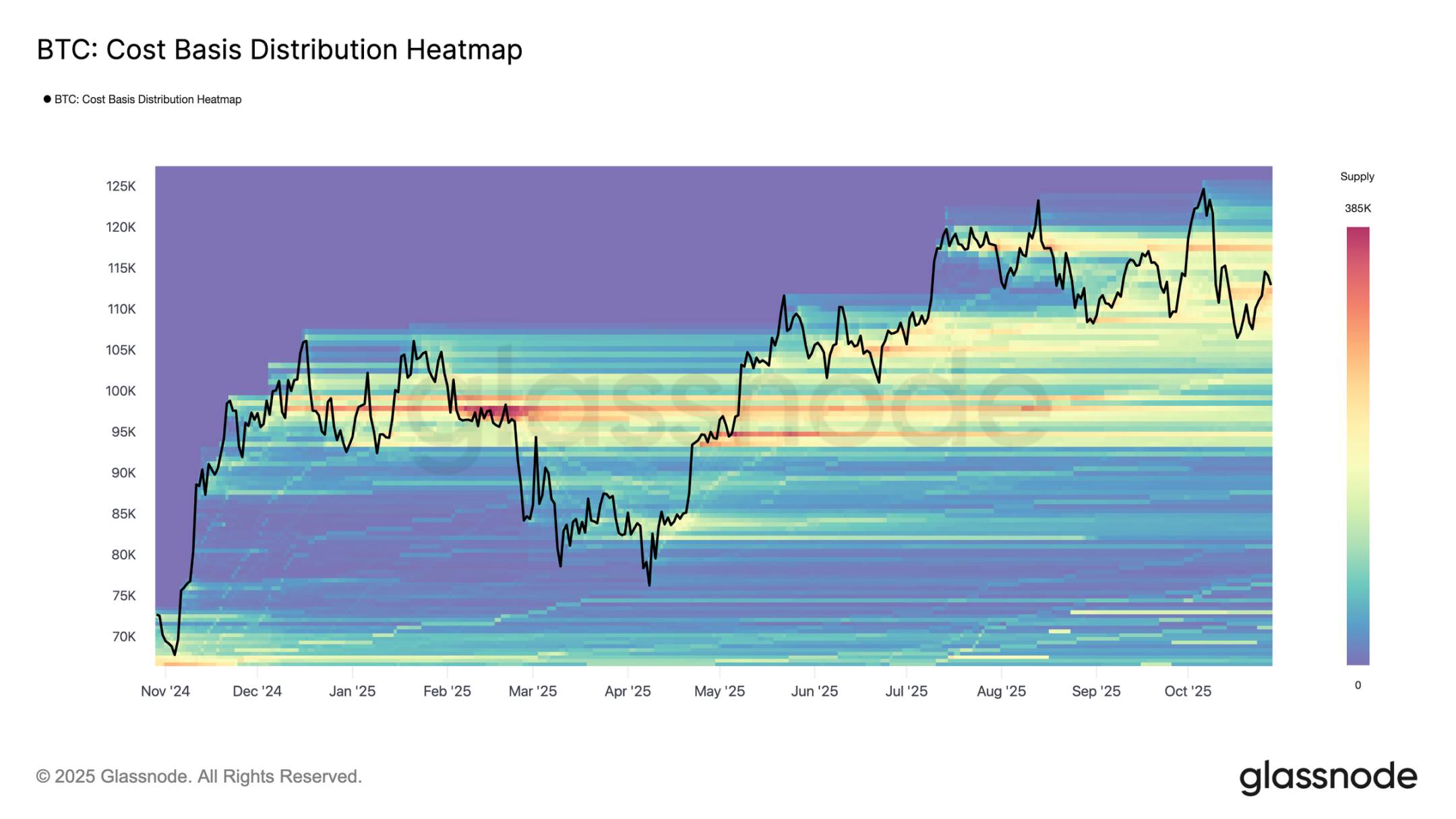
Struggling to Hold the Line
After the weekend rebound, Bitcoin briefly reclaimed the level near the cost basis of short-term holders at about $113K, which is typically seen as a dividing line between bullish and bearish momentum. Maintaining this threshold usually indicates that demand is strong enough to absorb ongoing selling pressure. However, failing to hold above this level, especially after trading higher for six months, suggests that demand is weakening.
Over the past two weeks, Bitcoin has struggled to close weekly candlesticks above this critical level, increasing the risk of further weakness in the future. If this phase continues, the next significant support level is near the realized price for active investors at about $88K, which reflects the cost basis of actively circulating supply and typically marks a deeper correction phase in previous cycles.
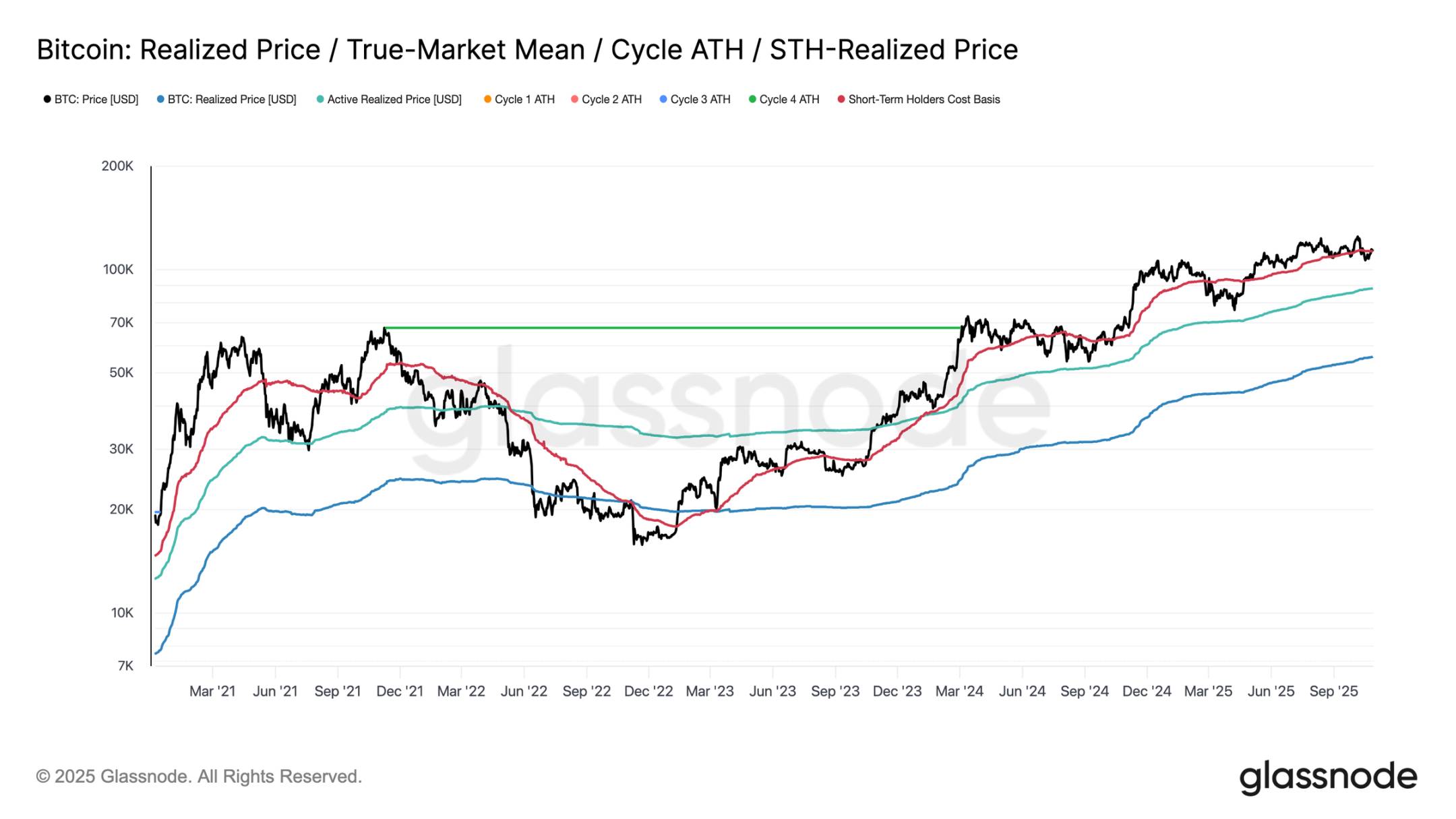
Pressure from Short-Term Holders
Expanding the analysis to investor sentiment, further market weakness is likely driven by short-term holders, who are now exiting at a loss as top buyers. The net unrealized profit/loss metric for short-term holders helps assess this pressure by measuring the proportion of unrealized profits or losses relative to market capitalization.
Historically, deep negative values coincide with the capitulation phase before market bottoms form. The recent drop to $107K pushed the net unrealized profit/loss for short-term holders to -0.05, compared to the typical range of -0.1 to -0.2 during mid-term bull market corrections, or below -0.2 during deep bear market lows, indicating a slight loss.
As long as Bitcoin trades within the top buyer cluster of $107K to $117K, the market remains in a delicate balance, not fully capitulated, but gradually turning against the bulls as confidence continues to erode.
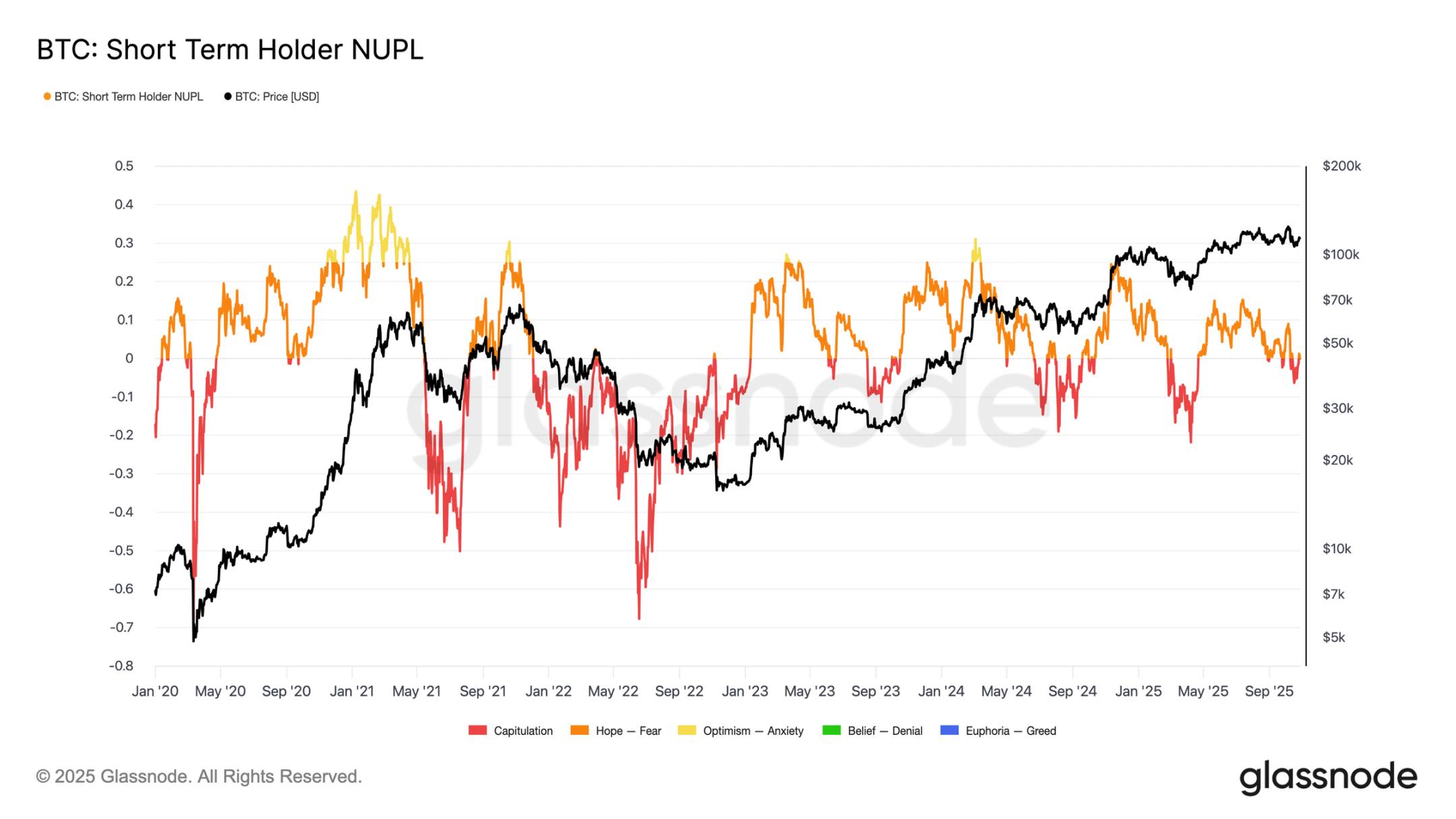
Selling Pressure from Long-Term Holders
Based on previous observations, the ongoing selling from long-term holders continues to weigh on market structure. The net position change for long-term holders has dropped to -104K BTC per month, highlighting the most significant wave of selling since mid-July.
This persistent selling pressure aligns with broader signs of exhaustion in the market, as seasoned investors continue to realize profits amid weakening demand.
Historically, major market expansions only begin after long-term holders shift from net selling to sustained accumulation. Therefore, a return to net positive inflows for this group remains a key prerequisite for restoring market resilience and laying the groundwork for the next bull market phase. Until this shift occurs, the selling from long-term investors is likely to continue pressuring price movements.
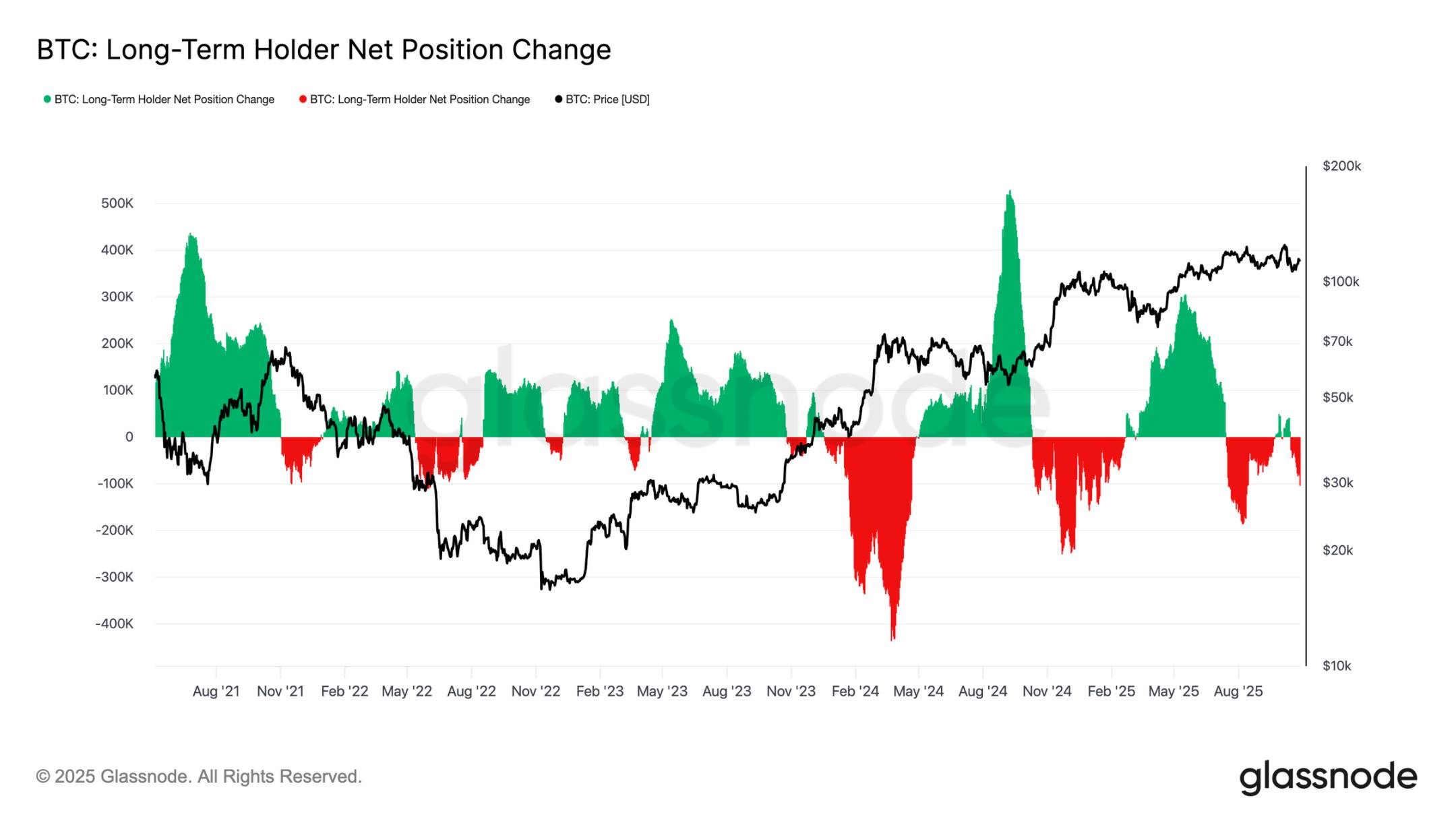
To gauge the intensity of long-term holder selling, we can look at the transfer volume of long-term holders to exchanges (30-day simple moving average), which captures the value of tokens moved by seasoned investors for potential sale. This metric has surged to about $293 million per day, more than double the widely observed benchmark level of $100 million to $125 million since November 2024.
Such high transfer activity indicates that long-term investors are continuously realizing profits, increasing ongoing selling pressure. The current pattern closely resembles that of August 2024, characterized by active spending from long-term holders while price momentum was slowing. Unless this transfer flow subsides, spot demand will struggle to absorb ongoing selling, making the market susceptible to further cooling in the coming weeks.
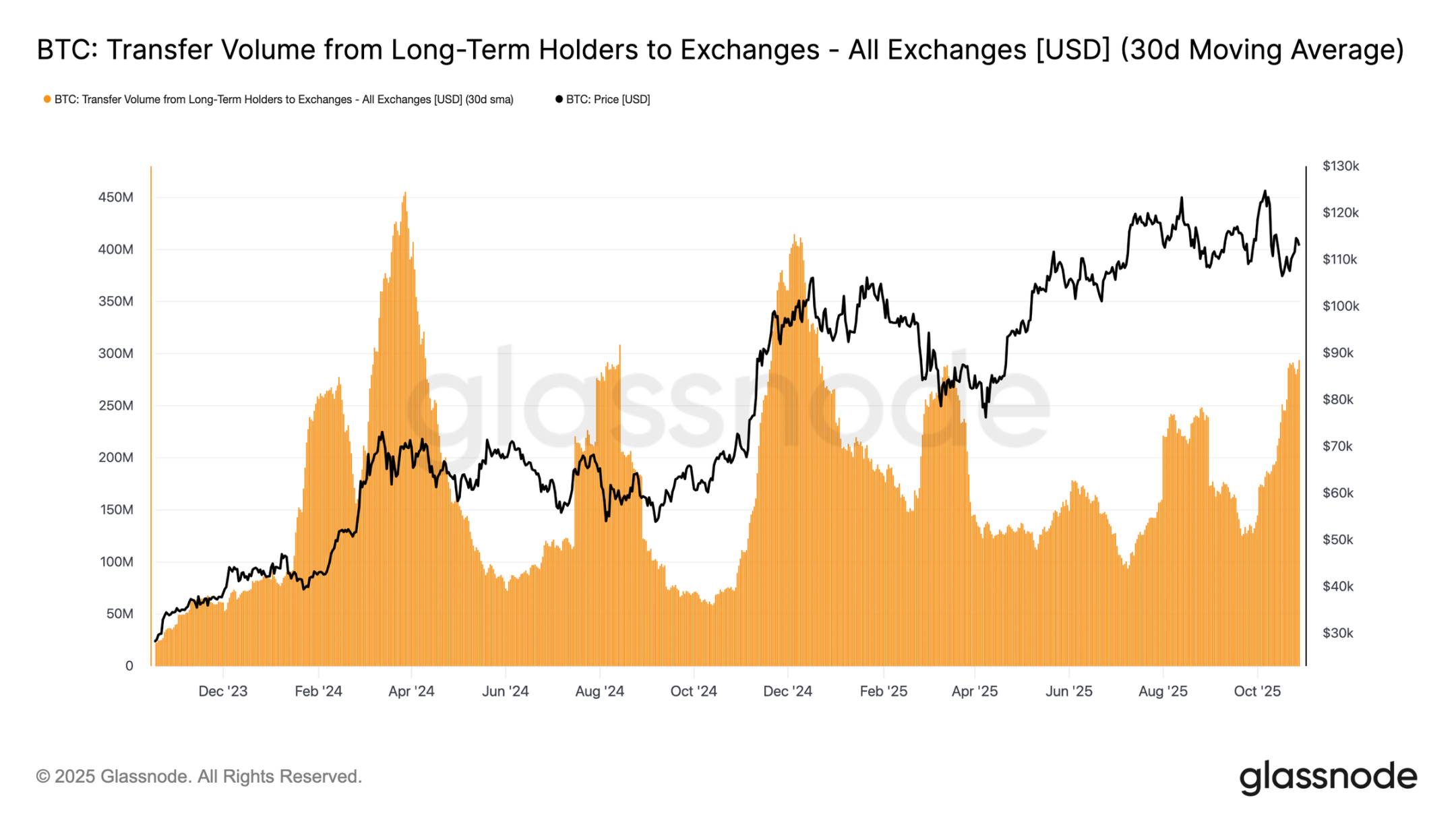
Off-Chain Insights
Cooling in the Options Market
Turning to the options market, recent data shows that the volatility pressure following the plunge on October 10 continues to ease. Bitcoin's 30-day realized volatility has dropped to 42.6%, slightly down from 44% last week, reflecting a calmer price movement. Meanwhile, the implied volatility, which represents trader expectations, has decreased more sharply as participants unwind downside hedges and reduce protection demand.
Shorter-term contracts have seen the most significant adjustments, with the 1-week at-the-money implied volatility dropping over 10 volatility points to about 40%, while 1-month to 6-month contracts have only declined by 1-2 points, maintaining around the 40% mid-term level. This flattening of the term structure indicates that traders expect recent shocks to diminish.
The curve also suggests that expected volatility will slowly rise to about 45% over the next few months, rather than experiencing a sharp spike.
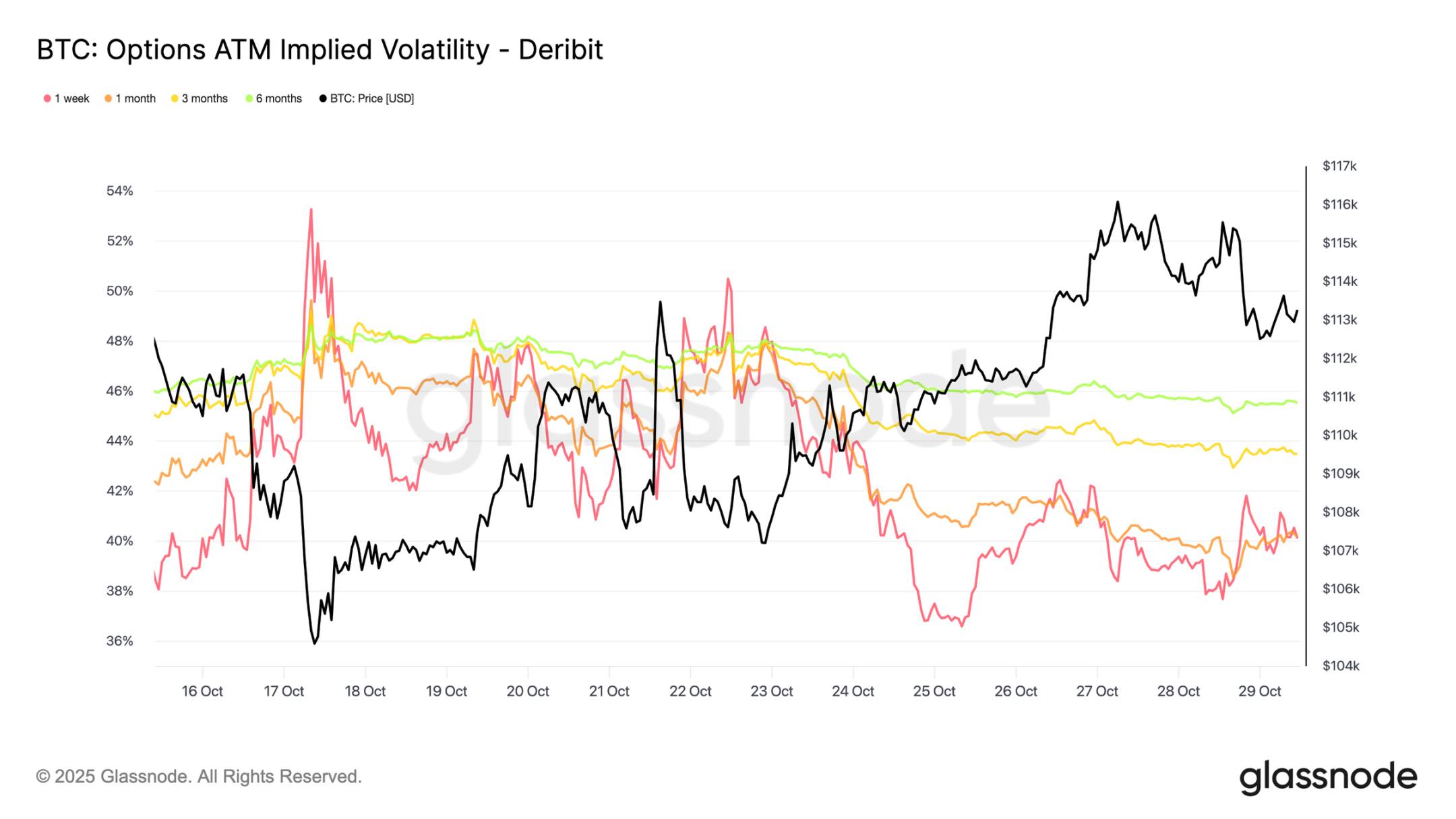
Skew Resetting Lower
The easing of implied volatility has also translated into a significant shift in the 25-Delta skew, which measures the relative cost of put options versus call options. Positive skew indicates a premium for put option trading. After the washout in October, the 1-week skew surged above 20%, indicating extremely high demand for downside protection. Since then, it has collapsed to neutral levels, with a slight rebound but at a much lower intensity.
Longer-term contracts, such as 1-month and 3-month, have also reset sharply, showing only moderate premiums for put options. This shift indicates that traders have removed most of their downside hedges. Positions are now closer to "moderately bullish/bidirectional" rather than "panic new lows," aligning with the broader stability seen in Bitcoin's recent price movements.
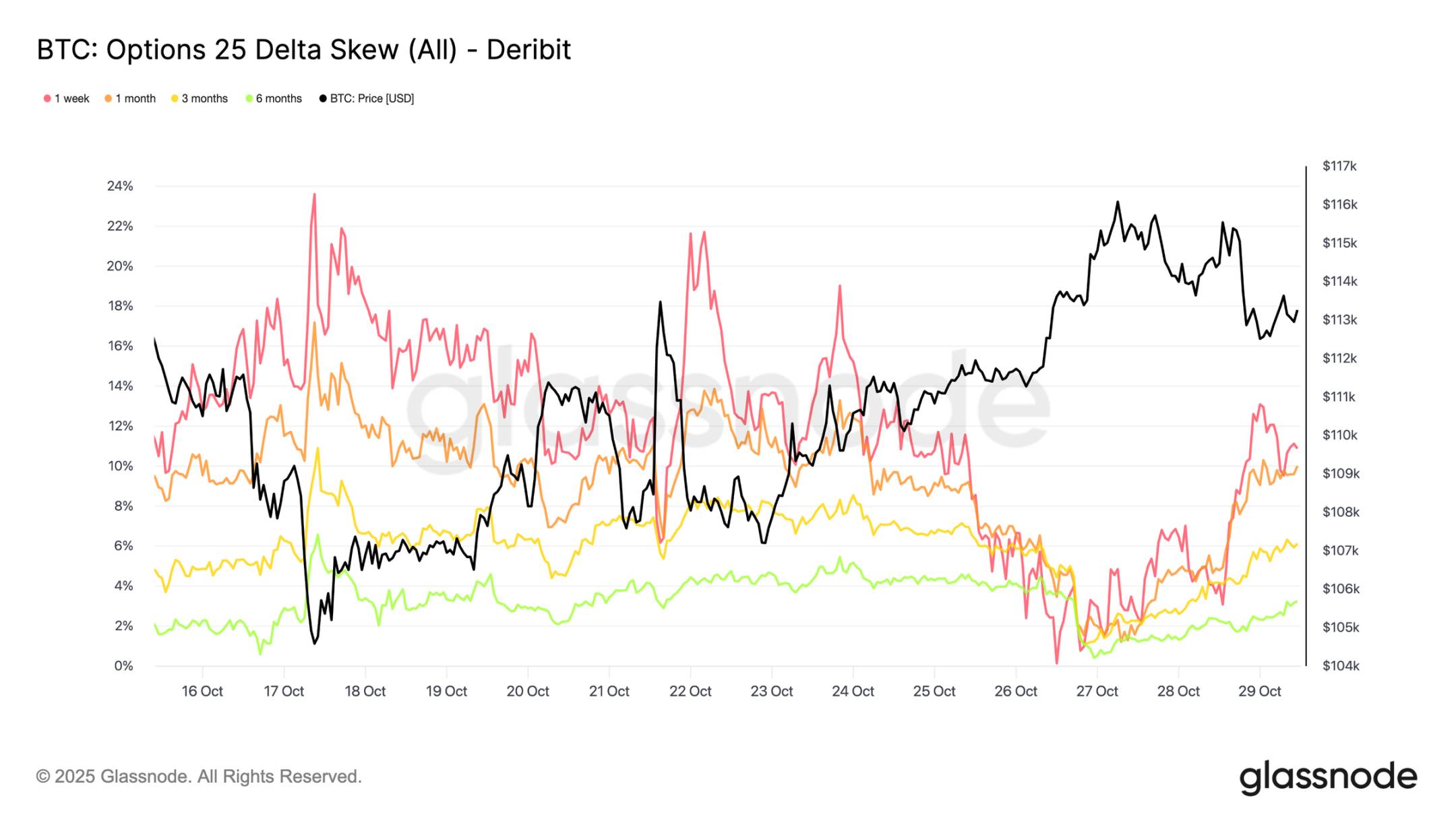
Selective Bullish Positions
As skew normalizes, attention turns to where traders are directing their premiums. Call option activity now varies significantly by strike price. At the $115K strike price, net buying of call options remains positive, indicating that traders continue to pay for recent upside potential as prices have recovered over the past two weeks. In contrast, at the $120K strike price, sold call options exceed bought ones, resulting in a net premium that is negative.
This setup reflects a stance of "moderate rebound, not a full breakout." Traders are willing to pay for gains closer to the spot price but are financing these positions by selling call options at higher strike prices. The resulting call spread structure suggests a cautiously optimistic view, seeking to participate in further upside while lacking confidence in a full retest of all-time highs.
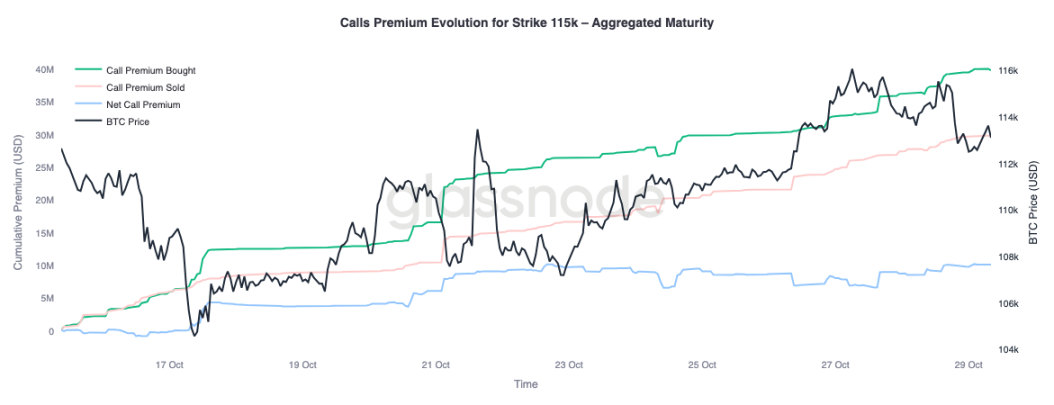
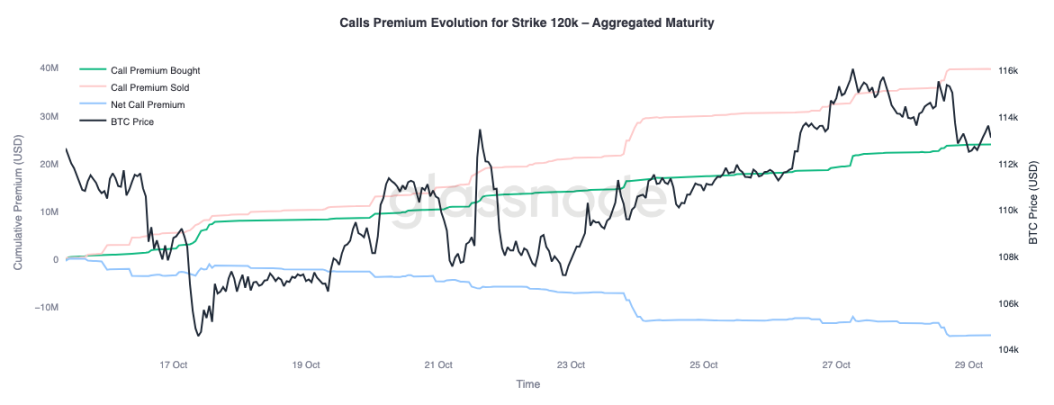
Market Pricing for Controlled Retracement
To complete the overall picture, we can turn to the bearish options side of the market. Since October 24, as Bitcoin has pushed higher, traders have been buying $110K put options, indicating demand for recent downside protection. Meanwhile, $105K put options have been sold more aggressively, suggesting that participants are willing to collect premiums by providing insurance at that deeper strike price.
This contrast highlights a market anticipating shallow retracements rather than another wave of major liquidations. Traders seem to believe that consolidation around current levels (hedged at $110K) is possible, but they see a lower likelihood of a complete drop below $105K. Overall positions support the view that the worst of the deleveraging in October is over, with the market now focused on range trading and volatility harvesting rather than defensive hedging against another sharp sell-off.
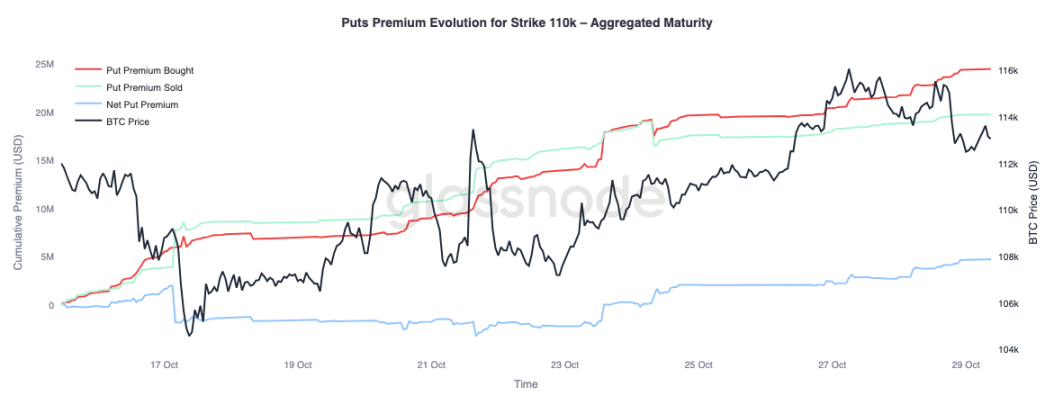
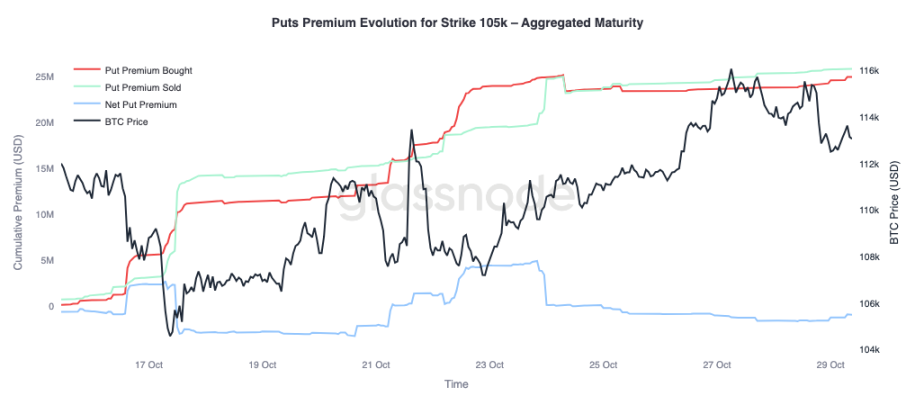
Conclusion:
The on-chain landscape continues to reflect a market in correction and recalibration. Bitcoin's failure to hold above the cost basis of short-term holders highlights the waning momentum and ongoing selling pressure from both short-term and long-term investors. The increased selling volume from long-term holders and high transfer volumes to exchanges underscore a phase of demand exhaustion, suggesting that the market may require an extended consolidation to rebuild confidence. Until long-term holders revert to accumulation mode, upward recovery may remain constrained.
Turning to the options market, front-end implied volatility has sharply declined, skew has normalized, and options flows now reflect controlled upside exposure and restrained downside hedging. Structurally, the crypto options market appears to be transitioning from crisis mode to rebuilding mode, indicating improved stability.
However, the next major catalyst is approaching, namely the Federal Reserve meeting. Rate cuts have been largely priced in, meaning a dovish outcome is likely to keep volatility suppressed and skew balanced. Conversely, if the Fed delivers a smaller rate cut or maintains a hawkish tone, short-term implied volatility may rise again, and the 25-Delta skew could widen as traders rush to repurchase protection. Essentially, the current calm in the market is conditional, stable for now, but vulnerable if the Fed deviates from expectations.
免责声明:本文章仅代表作者个人观点,不代表本平台的立场和观点。本文章仅供信息分享,不构成对任何人的任何投资建议。用户与作者之间的任何争议,与本平台无关。如网页中刊载的文章或图片涉及侵权,请提供相关的权利证明和身份证明发送邮件到support@aicoin.com,本平台相关工作人员将会进行核查。




